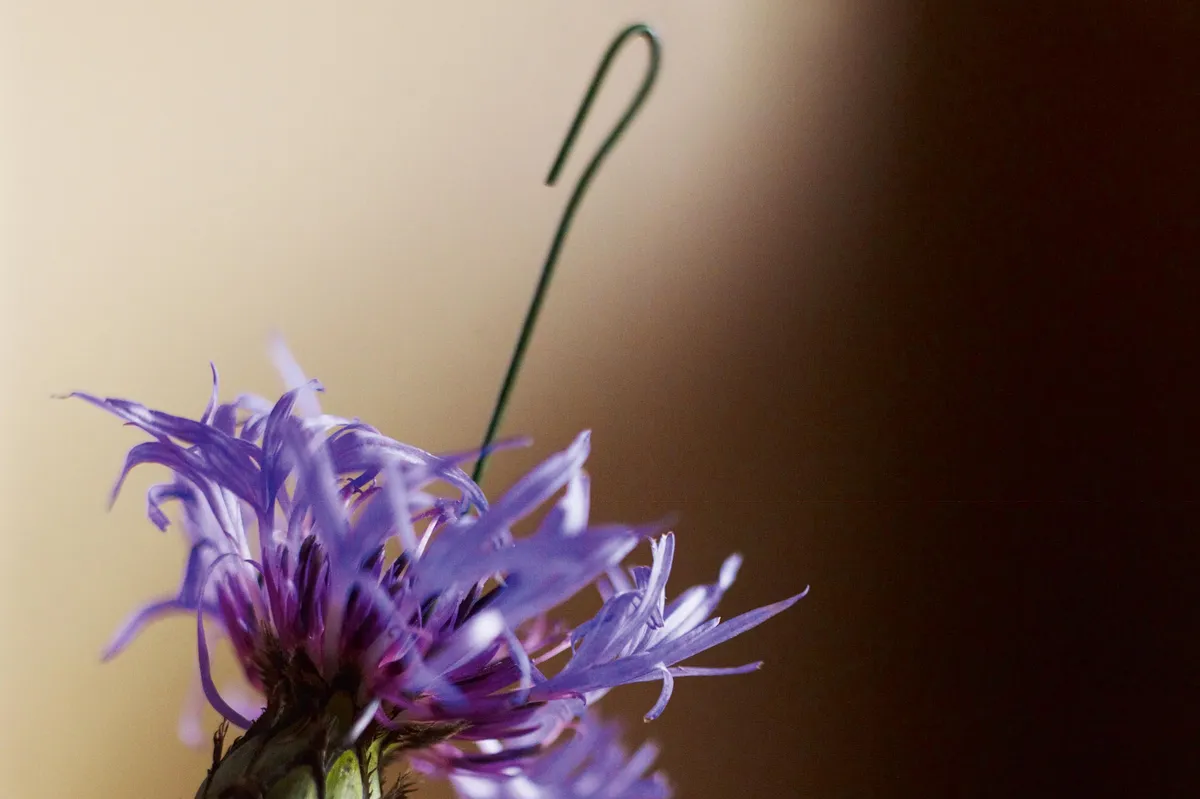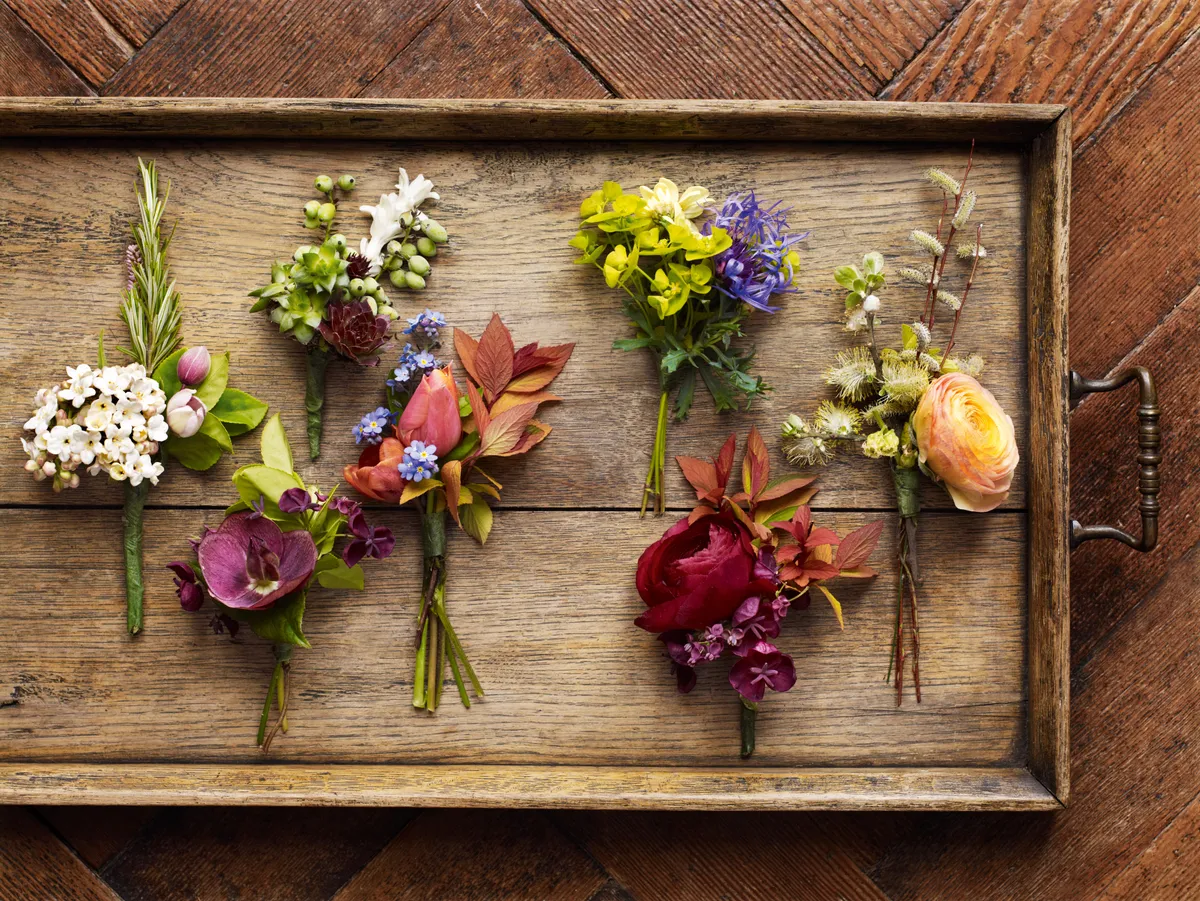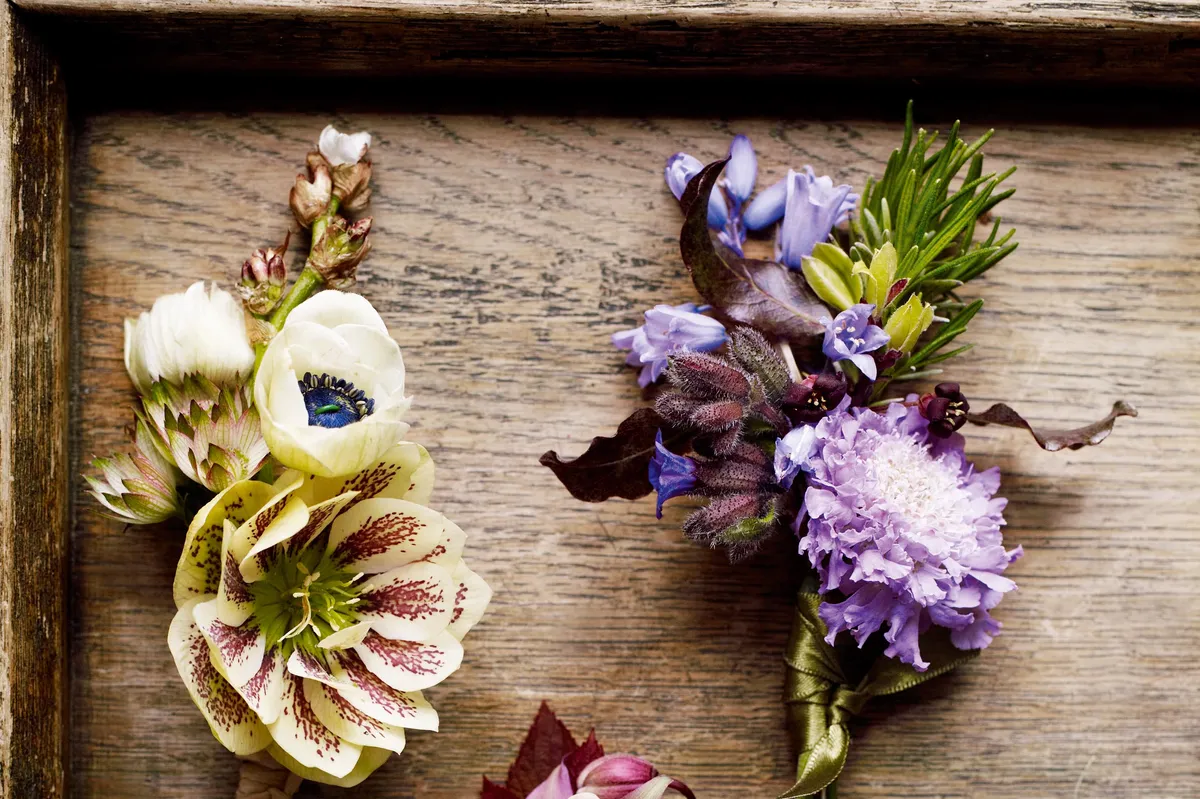A boutonniere is a little bouquet of buttonhole flowers, tucked into the lapel of a jacket or tuxedo and worn at a wedding, prom or funeral. It is traditionally worn by the father of the bride, groomsmen, ushers and male members of the family. The female equivalent of a boutonniere is a corsage, which tends to be more elaborate.
Most flowers can be made into these tiny lapel posies – lily of the valley, scented pinks (dianthus), cornflowers and nigella are all favourites of mine – and evergreen foliage, ornamental grasses and seedheads all last well, but this is an opportunity to use whatever you have to hand. If you bind stems with floral tape, then leave them in water overnight somewhere cool, they should comfortably last the day.
A boutonniere is so simple to make, so how about wearing one a little more often? You can simply pick a cut flower from your garden – or vase, or hedgerow – or craft something extraordinary to show your personal style.
Jump to
- How to make buttonhole flowers
- How to wear buttonhole flowers
- Which side to wear buttonhole flowers
- The best flowers for your buttonhole
- The history of the butonniere

How to make buttonhole flowers
If you want your buttonhole flowers to stay perky throughout the day you will need to wire your flowers to prevent the heads drooping or snapping. To do this you’ll need to thread wire through the flower’s calyx, make a loop and pull the wire back so the head is secure.

For best results for your boutonniere, leave the cut stems in water overnight then group your mix of flowers and foliage together. Bind your mix together with stem tape – wired flowers are easy to use as they can be moved into any position.
Whether you leave the stems bare or cover with tape is down to personal preference, but florist’s tape can help prevent flowers and foliage from drying out too fast. Florist’s wire, stem tape, sturdy pins and decorative extras, such as ribbon and raffia, can be bought from many online suppliers. You can also place the stems in pin vases.
How to wear buttonhole flowers
Which side to wear buttonhole flowers
A boutonniere is traditionally worn on the left. Even today, a well-made jacket often has a small loop on the underside of the lapel beneath the buttonhole to secure the stem, ideal for flowers, such as carnations or roses, with a large calyx.
But even with jackets without a loop it’s easy to stitch one, and equally fine to wear buttonhole flowers pinned flat on the outside of the lapel.

The best flowers for your buttonhole

From left to right:
Viburnum carlesii, Clematis montana buds, Euonymus fortunei and rosemary
The plants in this combination are as lovely for their scent as their form. Split the viburnum flower head into small sections and put in water overnight. Combine with buds and leaves before taping together into your boutonniere arrangement.
Hellebores
Hellebores are like little botanical treasures and last for days. Here I've mixed them with Akebia quinata and Euonymus fortunei foliage. Steep all the elements in water overnight before binding together.
Sempervivums and mahonia
The small succulent Sempervivum tectorum mixes well with these Mahonia japonica berries, and both will last for days without drooping. The hyacinth pips are also long lasting but will need wiring.
Forget-me-not, tulip and spiraea
Forget-me-not is always a great companion for tulips, as is this Spiraea japonica ‘Goldflame’ foliage. Secondary tulip flowers, such as this Tulipa ‘Prinses Irene’, are a perfect size for boutonnieres. Freshly picked tulips sometimes open and close with sunlight during the day, adding an element of unexpected movement to your lapel.
Argyranthemum frutescens, Centaurea montana and Euphorbia amygdaloides var. robbiae
Strip euphorbia flowers from the stem (beware – the sap can be a skin irritant) and leave in water overnight for the perfect boutonniere.
Spiraea, akebia and rancunclus
The russet leaves of Spiraea japonica ‘Goldflame’ along with the delicate pink flowers of Akebia quinata work well with heavy-headed, round flowers, such as this richly coloured Ranunculus, which if left in water overnight before wiring the heads, will last for several days.
Ranunculus and willow
Here a lovely yellow Ranunculus ‘Picotee’ is combined with Salix caprea and Salix purpurea ‘Nancy Saunders’ to great effect. It’s worth bearing in mind that all willows last well while at the catkin stage, however, the thin wiry stems of ‘Nancy Saunders’ are especially suited to a boutonniere.
Anemone and hellebore

(Left) Anemones make fabulous buttonholes and here the Anemone coronaria combines beautifully with the pretty speckled hellebore. Larger flowers need wiring, so they don’t droop, as will the Astrantia major and Libertia chilensis buds if they’re to stay perky.
Scilla, scabious, pulmonaria, pittosporum and rosemary
(Right) Bluebells make lovely buttonholes but very quickly droop. This scilla seedling is a great alternative and works well with the blues of Scabiosa caucasica and Pulmonaria ‘Blue Ensign’, counterbalanced by the pinkish foliage of Pittosporum tenuifolium ‘Tom Thumb’ and the green of the rosemary. Sear the scilla stems in just-boiled water for 20 seconds then leave in cold water for an hour before using.
Clematis, aquilegia, hellebore and spiraea

Most clematis last well if left in water overnight, but try to avoid using the youngest foliage as it tends to wilt. This Clematis montana works well with the colours of the aquilegia seedling, hellebore and Spiraea japonica ‘Anthony Waterer’ foliage. To make sure they last, it's worth searing the stems of aquilegias briefly in just-boiled water.
The history of the butonniere
Men used to wear boutonnieres, or buttonhole flowers, far more commonly than they do now. In the late 18th century fashionable chaps in England – known as macaronis because of the pasta they ate on their European Grand Tours – were known to wear entire bouquets in miniature as their boutonniere. Less flashy gentlemen often wore sprays of flowers in their buttonhole as the frock coat emerged as general wear, its turned-down collar forming a lapel with an exposed buttonhole, and as bright costumes became more sober, the buttonhole flower became fashionable as a splash of colour on a plain jacket.
By the late 19th century a boutonniere was the mark of a careful dresser, worn by politicians and professionals as well as dandies. After the First World War, poppies emerged as a symbol of remembrance, and are still worn around Remembrance Day, but otherwise floral adornment was rarely seen in the early 20th century.
The fortunes of boutonnieres revived a little in the 1950s, when film stars, such as Cary Grant, sported one. More recently, Agatha Christie’s dapper detective Hercule Poirot, as portrayed by David Suchet on TV, was frequently seen with a flower on his lapel, often placed in a miniature vase for added elegance.
Looking for the perfect outdoor wedding venue?
